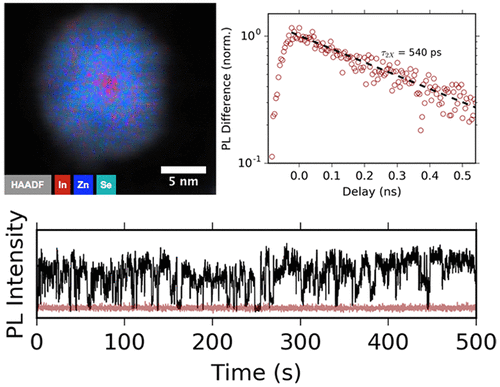当前位置:
X-MOL 学术
›
Nano Lett.
›
论文详情
Our official English website, www.x-mol.net, welcomes your
feedback! (Note: you will need to create a separate account there.)
Chemical Structure, Ensemble and Single-Particle Spectroscopy of Thick-Shell InP–ZnSe Quantum Dots
Nano Letters ( IF 9.6 ) Pub Date : 2018-01-02 00:00:00 , DOI: 10.1021/acs.nanolett.7b03703 Kemar R. Reid 1 , James R. McBride 1 , Nathaniel J. Freymeyer 1 , Lucas B. Thal 1 , Sandra J. Rosenthal 1
Nano Letters ( IF 9.6 ) Pub Date : 2018-01-02 00:00:00 , DOI: 10.1021/acs.nanolett.7b03703 Kemar R. Reid 1 , James R. McBride 1 , Nathaniel J. Freymeyer 1 , Lucas B. Thal 1 , Sandra J. Rosenthal 1
Affiliation

|
Thick-shell (>5 nm) InP–ZnSe colloidal quantum dots (QDs) grown by a continuous-injection shell growth process are reported. The growth of a thick crystalline shell is attributed to the high temperature of the growth process and the relatively low lattice mismatch between the InP core and ZnSe shell. In addition to a narrow ensemble photoluminescence (PL) line-width (∼40 nm), ensemble and single-particle emission dynamics measurements indicate that blinking and Auger recombination are reduced in these heterostructures. More specifically, high single-dot ON-times (>95%) were obtained for the core–shell QDs, and measured ensemble biexciton lifetimes, τ2x ∼ 540 ps, represent a 7-fold increase compared to InP–ZnS QDs. Further, high-resolution energy dispersive X-ray (EDX) chemical maps directly show for the first time significant incorporation of indium into the shell of the InP–ZnSe QDs. Examination of the atomic structure of the thick-shell QDs by high-angle annular dark-field scanning transmission electron microscopy (HAADF-STEM) reveals structural defects in subpopulations of particles that may mitigate PL efficiencies (∼40% in ensemble), providing insight toward further synthetic refinement. These InP–ZnSe heterostructures represent progress toward fully cadmium-free QDs with superior photophysical properties important in biological labeling and other emission-based technologies.
中文翻译:

厚壳InP–ZnSe量子点的化学结构,集合体和单颗粒光谱
据报道,通过连续注入壳的生长过程生长的厚壳(> 5 nm)InP-ZnSe胶体量子点(QD)。厚的结晶壳的生长归因于生长过程的高温以及InP核与ZnSe壳之间相对较低的晶格失配。除了窄的整体光致发光(PL)线宽(〜40 nm),整体和单粒子发射动力学测量还表明,这些异质结构中的闪烁和俄歇重组减少了。更具体地,高单点是为核-壳量子点获得的接通-时间(> 95%),和测量的合奏双激子的寿命,τ 2 X约540 ps,比InP–ZnS量子点增加了7倍。此外,高分辨率的能量色散X射线(EDX)化学图谱首次直接显示出铟已大量掺入InP-ZnSe QD的壳层中。通过高角度环形暗场扫描透射电子显微镜(HAADF-STEM)对厚壳量子点的原子结构进行的检查揭示了粒子亚群中的结构缺陷,这些缺陷可能会降低PL效率(合计约40%),从而提供了见识进行进一步的合成改进。这些InP-ZnSe异质结构代表了向具有生物物理标记和其他基于发射技术的重要光物理特性的完全无镉量子点的发展。
更新日期:2018-01-02
中文翻译:

厚壳InP–ZnSe量子点的化学结构,集合体和单颗粒光谱
据报道,通过连续注入壳的生长过程生长的厚壳(> 5 nm)InP-ZnSe胶体量子点(QD)。厚的结晶壳的生长归因于生长过程的高温以及InP核与ZnSe壳之间相对较低的晶格失配。除了窄的整体光致发光(PL)线宽(〜40 nm),整体和单粒子发射动力学测量还表明,这些异质结构中的闪烁和俄歇重组减少了。更具体地,高单点是为核-壳量子点获得的接通-时间(> 95%),和测量的合奏双激子的寿命,τ 2 X约540 ps,比InP–ZnS量子点增加了7倍。此外,高分辨率的能量色散X射线(EDX)化学图谱首次直接显示出铟已大量掺入InP-ZnSe QD的壳层中。通过高角度环形暗场扫描透射电子显微镜(HAADF-STEM)对厚壳量子点的原子结构进行的检查揭示了粒子亚群中的结构缺陷,这些缺陷可能会降低PL效率(合计约40%),从而提供了见识进行进一步的合成改进。这些InP-ZnSe异质结构代表了向具有生物物理标记和其他基于发射技术的重要光物理特性的完全无镉量子点的发展。











































 京公网安备 11010802027423号
京公网安备 11010802027423号